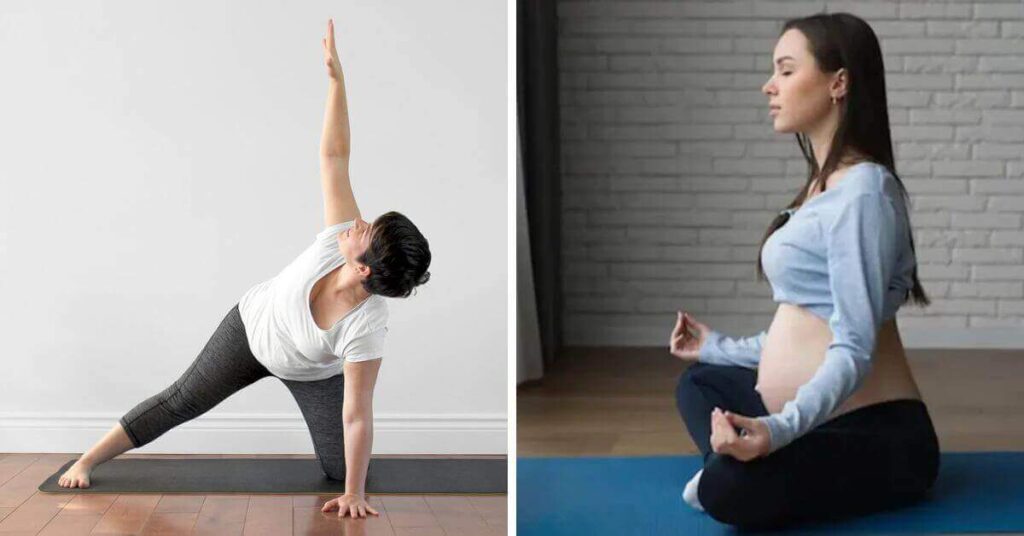The first trimester of pregnancy marks the beginning of an incredible journey filled with excitement, anticipation, and numerous physical and emotional changes. As your body adapts to support new life, you may experience fatigue, morning sickness, mood swings, and hormonal fluctuations. During this transformative phase, gentle movement can be highly beneficial this is where first trimester yoga comes in.
Practicing yoga early in pregnancy helps improve blood circulation, reduce stress, alleviate nausea, and build strength for the months ahead. It also fosters a deep mind-body connection, helping you stay centered and calm during this delicate stage. However, not all yoga poses are safe during pregnancy, making it essential to modify postures and listen to your body’s cues.
This guide explores the benefits, safe poses, and expert-backed tips to help you practice yoga with confidence. Whether you’re a seasoned yogi or a beginner, first trimester yoga can support a healthier, more balanced pregnancy.
What is First Trimester Yoga?
1. Understanding First Trimester Yoga
First trimester yoga is a form of prenatal yoga tailored specifically for women in the first three months of pregnancy. This stage is characterized by significant hormonal shifts, early pregnancy symptoms like nausea and fatigue, and the body’s initial adaptations to support fetal growth. Unlike traditional yoga, first trimester yoga prioritizes gentle movements and mindful breathing techniques to enhance physical and emotional well-being while ensuring safety for both mother and baby.
2. The Purpose of First Trimester Yoga
The primary goal of first trimester yoga is to provide physical and mental support during the early pregnancy phase. This practice helps:
- Improve blood circulation for better oxygen and nutrient supply to the baby.
- Alleviate early pregnancy discomforts like morning sickness, bloating, and mood swings.
- Strengthen muscles, particularly in the pelvic region, to prepare the body for future pregnancy stages.
- Reduce stress and promote emotional balance through breathwork and meditation.
3. Differences from Traditional Yoga
Unlike general yoga, first trimester yoga incorporates modified postures that avoid excessive abdominal pressure, deep twists, and intense core engagement. The focus is on slow, controlled movements and relaxation techniques rather than vigorous exercise. Certain high-risk postures, such as deep backbends and inversions, are typically avoided to ensure maternal and fetal safety.
4. Importance of Breathwork in First Trimester Yoga
Pranayama (breath control) plays a crucial role in first trimester yoga. Controlled breathing techniques such as deep belly breathing and alternate nostril breathing enhance oxygen flow, reduce anxiety, and help manage early pregnancy symptoms. These techniques also prepare the body for labor by promoting relaxation and mindfulness.
5. How First Trimester Yoga Supports a Healthy Pregnancy
Practicing yoga in the first trimester sets the foundation for a smoother pregnancy. It strengthens the body, improves flexibility, and cultivates inner calm, which can be beneficial throughout pregnancy and during childbirth. By embracing gentle movements and mindful breathing, expectant mothers can support both their own well-being and the healthy development of their baby.
Why First Trimester Yoga is Beneficial
The first trimester is a transformative period in pregnancy, marked by rapid hormonal shifts, early pregnancy symptoms, and significant physical and emotional changes. Many women experience fatigue, nausea, anxiety, and mood swings as their bodies adjust to nurturing new life.
Yoga offers a safe, gentle, and highly effective way to navigate these changes while supporting overall well-being. A consistent first trimester yoga routine provides numerous physical, emotional, and mental benefits that can positively impact both the mother and the growing baby.
1. Reduces Stress and Anxiety
One of the most significant benefits of yoga during pregnancy is its ability to lower stress and anxiety. The first trimester can be overwhelming, with fluctuating emotions, medical appointments, and the excitement (or nervousness) of impending motherhood. Yoga helps regulate cortisol levels (the body’s primary stress hormone) while promoting the production of endorphins, which enhance mood and relaxation.
Breathing techniques such as deep belly breathing (diaphragmatic breathing) and alternate nostril breathing (Nadi Shodhana) calm the nervous system and help expectant mothers feel more grounded. Mindfulness and meditation incorporated into a yoga practice further support emotional stability, reducing feelings of worry or unease.
2. Improves Blood Circulation
Good circulation is essential for both maternal health and fetal development. As pregnancy progresses, increased blood volume and hormonal changes can sometimes lead to poor circulation, swelling, or varicose veins. First trimester yoga helps stimulate blood flow, ensuring a steady supply of oxygen and nutrients to the baby.
Gentle yoga poses like Cat-Cow (Marjaryasana-Bitilasana), Bound Angle Pose (Baddha Konasana), and Legs-Up-The-Wall (Viparita Karani) encourage better circulation while also relieving tension in the back and legs.
3. Alleviates Nausea and Morning Sickness
Morning sickness is one of the most common first-trimester symptoms, affecting nearly 70-80% of pregnant women. While severe cases (hyperemesis gravidarum) require medical attention, mild to moderate nausea can be managed through breathwork and gentle movement.
Yoga helps regulate the autonomic nervous system, which plays a role in digestion. Certain poses like Seated Forward Fold (Paschimottanasana) and Child’s Pose (Balasana) can help soothe nausea and promote digestive comfort. Practicing slow, rhythmic breathing can also reduce dizziness and queasiness.
4. Increases Energy Levels
Fatigue is common during the first trimester due to rising progesterone levels and increased energy demands on the body. Many women find themselves feeling sluggish, sleepy, or lacking motivation to stay active.
Engaging in gentle yoga helps boost oxygen intake, enhances blood circulation, and naturally increases energy levels without overstimulating the body. Simple movements like Standing Side Stretches, Warrior II (Virabhadrasana II), and Open Chest Stretches can leave pregnant women feeling refreshed and revitalized.
Yoga also improves sleep quality, helping expectant mothers get the restorative rest needed for a healthy pregnancy.
5. Strengthens Pelvic Muscles and Core Stability
A strong pelvic floor and core muscles are essential for carrying a growing baby and supporting the uterus as it expands. While intense abdominal workouts should be avoided, first trimester yoga offers safe and effective ways to maintain core stability.
Kegel exercises, Modified Planks, and Supported Squats help strengthen the pelvic region, reducing the risk of pelvic pain and incontinence later in pregnancy. Strengthening these muscles early on can also promote a smoother labor and postpartum recovery.
6. Promotes Emotional Balance and Self-Awareness
Pregnancy is not just a physical journey it’s an emotional and mental one as well. First trimester yoga helps women develop a deeper mind-body connection, fostering greater self-awareness and emotional resilience.
By practicing gratitude meditations, guided visualization, and positive affirmations, pregnant women can cultivate a sense of calm, confidence, and empowerment. Yoga encourages expectant mothers to embrace the changes in their bodies with acceptance and mindfulness.
7. Prepares the Body for Later Pregnancy Stages
The foundation built through first trimester yoga helps women transition smoothly into the second and third trimesters. Establishing a yoga routine early on strengthens the body, improves flexibility, and conditions the muscles needed for a healthy pregnancy and childbirth.
By maintaining a consistent practice, women can prevent common pregnancy discomforts such as back pain, swelling, and joint stiffness, making the journey to delivery more comfortable.
8. Encourages a Positive Pregnancy Experience
A positive mindset plays a crucial role in a healthy pregnancy. Practicing yoga helps women feel more in control of their changing bodies and prepares them for the emotional and physical demands of motherhood. Whether it’s through breathing techniques, movement, or meditation, yoga provides tools to navigate pregnancy with greater ease and joy.
By incorporating yoga into a daily or weekly routine, pregnant women can experience a more balanced, energized, and harmonious first trimester while setting the stage for a smoother pregnancy journey ahead.
Safe Yoga Poses for the First Trimester
During the first trimester, your body undergoes significant hormonal and physiological changes. While yoga can be highly beneficial, it’s crucial to practice poses that are safe, supportive, and aligned with the unique needs of early pregnancy. The following yoga poses help maintain flexibility, strengthen key muscle groups, and promote relaxation without putting unnecessary strain on the body.
1. Cat-Cow Pose (Marjaryasana-Bitilasana)
This gentle spinal movement enhances flexibility, relieves lower back tension, and improves circulation. It also supports digestion, helping ease bloating and nausea.
How to do it:
- Start in a tabletop position with wrists under shoulders and knees under hips.
- Inhale, arch your back, lift your tailbone, and gaze up (Cow Pose).
- Exhale, round your spine, tuck your chin, and draw your belly inward (Cat Pose).
- Repeat for 5-10 slow breaths.
Why it’s safe: This pose is gentle on the abdomen and strengthens the spine without putting pressure on the uterus.
2. Bound Angle Pose (Baddha Konasana)
This hip-opening pose improves circulation to the pelvic region and relieves tension in the inner thighs and groin.
How to do it:
- Sit on the floor with your legs extended.
- Bring the soles of your feet together and let your knees drop outward.
- Hold your feet and gently press your knees toward the floor.
- Maintain a straight spine and breathe deeply for 5-10 breaths.
Why it’s safe: It encourages hip flexibility without over-stretching, making it beneficial for pelvic health.
3. Standing Forward Bend (Uttanasana) – Modified
This pose improves blood circulation, reduces fatigue, and releases tension in the hamstrings and lower back.
How to do it:
- Stand with feet hip-width apart.
- Slowly fold forward from the hips, keeping a slight bend in the knees.
- Let your arms hang or rest on a yoga block for support.
- Hold for 5 breaths and rise slowly.
Why it’s safe: The modified version avoids compression of the abdomen while improving flexibility and circulation.
4. Warrior II (Virabhadrasana II)
A grounding pose that strengthens the legs, improves balance, and enhances endurance, all of which are beneficial as pregnancy progresses.
How to do it:
- Stand with feet wide apart, turning one foot outward and keeping the other slightly inward.
- Bend the front knee while keeping the back leg straight.
- Extend arms parallel to the floor and gaze over the front hand.
- Hold for 5 breaths on each side.
Why it’s safe: It strengthens leg muscles and builds stamina without putting pressure on the abdomen.
5. Child’s Pose (Balasana) – Wide-Knee Variation
This resting pose relieves stress, reduces nausea, and gently stretches the hips, back, and shoulders.
How to do it:
- Kneel on the floor, bringing your big toes together and spreading your knees apart.
- Sit back on your heels and extend your arms forward.
- Rest your forehead on the mat and breathe deeply.
- Stay for 5-10 breaths.
Why it’s safe: It promotes relaxation and gently stretches the lower back without compressing the belly.
6. Legs Up the Wall Pose (Viparita Karani)
A restorative pose that improves circulation, reduces swelling in the legs, and alleviates fatigue.
How to do it:
- Sit sideways against a wall and swing your legs up.
- Keep your back flat on the floor and relax your arms by your sides.
- Hold for 5-10 minutes, breathing deeply.
Why it’s safe: It reduces pressure on the lower back and helps with pregnancy-related swelling and fatigue.
These first-trimester-friendly poses support flexibility, circulation, and relaxation while ensuring the safety of both the mother and baby. Always listen to your body, avoid overexertion, and consult your doctor before starting a yoga routine.

Precautions for First Trimester Yoga
Practicing yoga during the first trimester can be highly beneficial, but it’s essential to take precautions to ensure both maternal and fetal safety. Since the first trimester is a crucial period for embryonic development, it’s important to approach yoga with mindfulness and care.
1. Avoid Overexertion
The body undergoes hormonal changes that can lead to fatigue and dizziness. Avoid pushing yourself too hard practice at a gentle pace and take breaks when needed. Listen to your body’s signals and stop immediately if you feel discomfort.
2. Steer Clear of Deep Twists and Intense Core Work
Deep spinal twists and strong abdominal exercises can compress the uterus and should be avoided. Instead, focus on gentle movements that enhance flexibility without putting strain on the belly.
3. Be Cautious with Balance Poses
Hormonal changes affect joint stability, increasing the risk of falls. When practicing balance poses, use a wall or chair for support to prevent injury.
4. Avoid Lying Flat on Your Back for Extended Periods
While lying on your back is generally safe in the first trimester, prolonged supine positions can reduce blood flow to the uterus. Opt for side-lying or propped-up variations when needed.
5. Stay Hydrated and Practice in a Cool Environment
Overheating can be harmful during pregnancy. Drink plenty of water and practice in a well-ventilated space to maintain a comfortable body temperature.
Always consult your healthcare provider before starting a first trimester yoga routine to ensure it aligns with your individual pregnancy needs.
FAQs:
Is it safe to start yoga in the first trimester?
Yes, as long as you practice gentle poses and avoid high-intensity movements.
Can yoga reduce first-trimester nausea?
Yes, certain breathing techniques and poses can ease nausea and support digestion.
Are inversions safe during the first trimester?
It’s best to avoid inversions to prevent dizziness and blood pressure fluctuations.
Can first trimester yoga help with fatigue?
Absolutely! Yoga enhances oxygen circulation, helping to combat pregnancy-related exhaustion.
What type of yoga is best during the first trimester?
Prenatal yoga, Hatha yoga, and gentle flow yoga are the safest options.
Should I consult my doctor before doing yoga?
Yes, always check with your healthcare provider before starting or continuing yoga during pregnancy.
Conclusion
First trimester yoga offers a wealth of benefits, from reducing stress to improving blood circulation. By practicing safe poses, listening to your body, and following expert guidance, you can enjoy a healthier and more comfortable pregnancy. Always prioritize gentle movements and consult your doctor before starting a new yoga routine.







